This selection of post-war pubs comes from 1961 editions of in-house magazines from two London brewing behemoths, Watney’s and Whitbread.
To reiterate what we said a few weeks ago, the primary point of this series of posts is to put the material in these publications somewhere where other people can find it. And, for clarity, we should say that these pubs weren’t all built or opened in 1961 — that’s just when the magazines covered them. Where a date of construction or opening is given, or is available from another reliable source, we’ve included it, along with the names of architects and photographers where possible.
1. The Buff Orpington, Orpington, Greater London (Kent)

This Whitbread pub was the permanent replacement for a prefab that was erected as a stopgap immediately after World War II. The lounge, in black and white, was decorated with reproductions of paintings of chickens, the Buff Orpington being a breed of hen. The tap room (public bar) had lemon walls and a red and blue tiled floor — so, something like this?

Is it still there? Yes, under the name The Buff, and it’s yet another post-war estate pub run by Greene King who seem to be keeping it in good nick, even if it has had some faux-Victorian bits glued on.
2. The Royal Engineer, Gillingham, Kent

The original pub of this name was at Chatham, near the Royal Engineers’ barracks. This new pub — a fairly handsome building for the period — was built by Whitbread as part of the shopping centre on a new estate at Twydall:
Where in the old house were shutters and frosted glass are now clear panes and airy louvres. Special attention has been paid to heating and ventilation; a pleasing feature is the lighting — more and smaller bulbs giving brightness without glare. Richly hued woods in servery, counters and doors set off with light paint and wallpaper… An unusual feature is the porcelain handles of the beer pumps. On each is a reproduction of the inn sign.
We can imagine some people reading that thinking that the shutters and frosted glass sound much nicer.
This one is no longer in operation having been turned into a takeaway restaurant fairly recently, it seems.
3. The Horse & Groom, Sidcup, Greater London (Kent)

This new building, which took about a year to construct, replaced an older pub damaged by a landmine in 1940. It was declared open by Whitbread drayman Jack Strickland pictured here (left) with Charles Whitbread (centre) and colleague Charles Gibbons:

Is the pub still there? It is, only it’s now a pub-restaurant in the Harvester chain and has a slightly bizarre makeover with a fake rusticated extension designed to suggest, we assume, that this is a Quaint Old Inn™.
4. The Salmon Leap, Totton, Hampshire…

5. …and the Gardeners Arms, Woolston, Hampshire

We’ve jumped ahead a bit here because you really need to look at these two pubs in the suburbs of Southampton as a pair. It’s a standing joke that post-war pubs all look the same but here Watney’s really were operating an off-the-peg system. These two buildings were built to the same design using a prefabricated construction system. Both were thrown up in six months or so apiece and Watney’s were proud of their ‘strikingly modern’ appearance.
Perhaps surprisingly given the nature of their construction both are still there, still trading, and apparently hardly changed. There’s a bit of drama in the Whatpub listing for The Salmon Leap — ‘Pub survey attempted 14/12/2016 but the then landlord rejected the approach and seems to have banned his staff from saying anything at all’ — and you can get a good look at the Gardener’s via Street View:
6. The Highwayman, Roehampton, London (Surrey)
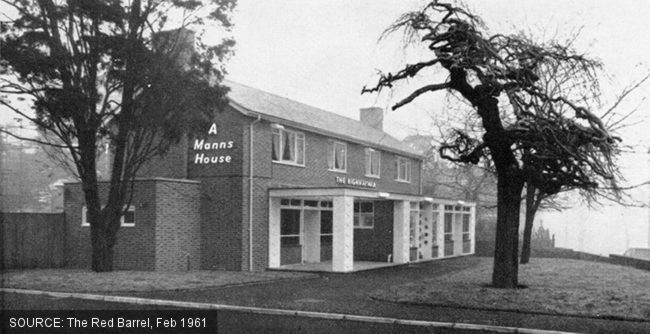
This pub, branded Mann’s rather than Watney’s, was named for a famous highwayman, Jerry Abershaw. He worked the London to Portsmouth road and was hanged near the site of the pub before being left on display for three years as a warning to others. (Blimey.)

Our favourite detail in the description of this pub is that ‘The tables in the saloon bar are topped with a plastic laminate which is decorated with attractive drawings of flintlock pistols’. No-one would even think of decorating a pub with pictures of guns today, would they? Even quaint antique ones.
Still there? Sadly not — demolished in 2014, according to WhatPub, which also tells us that it was on the CAMRA heritage list thanks to a well-preserved interior. We will try to track down some pictures.
7. The Moby Dick, Chadwell Heath, Essex
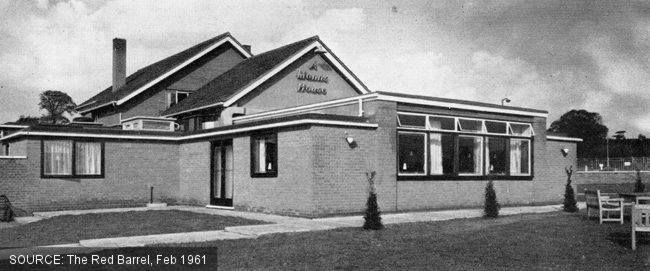
This pub sounds a lot like a restaurant: seats for 80 for lunch and dinner, or a hundred seated banquet style, and a ‘supper menu’ of 97 dishes. It had a large mural of a whale hunt by Hugh Robson, nephew of the actress Dame Flora Robson. Is it still there? Yes! From Street View it appears to have had a vintage-style makeover, though, with traditional Essex-style weatherboarding and a weather vane. It is now a Toby Carvery — not unfitting.
8. The Sportsman, Dunstable, Bedfordshire

This pub was part of a plan to reduce the number of pubs in the town centre and move the licences out to new housing estates. The Sportsman was on the Hadrian estate and had a lounge, darts area and off-licence. The offie was larger than usual because they expected plenty of people on the estate to buy to drink at home — but why? Because they couldn’t afford the pub, or because they drank an unusual amount, or some combination of the two?
Here’s George Mann, a director at Watney Mann from the Mann’s side (obviously) pulling the first pint watched by the mayor (left) and the licensee Mr Palmer.

And it’s still there, too — a ‘comfy estate pub’ with conversation, games and a single changing real ale according to the local CAMRA branch.
9. Hobson’s Choice, Spinney Hill, Warwick, Warwickshire

There’s no exterior shot of this pub which opened officially on 31 March 1961 to serve the Percy Estate. It was designed by the in-house architects of Phipps, a Northampton brewery taken over by Watney Mann in 1960. Above is the ‘luxurious lounge’ which led through to a refreshment room (cafe) intended mostly for the use of children.
Is it still there? No. It was boarded up for a while according to WhatPub, which also reveals that it was for a time known as Images — the quintessential 1980s nightclub name — and the site now appears to have several new-build houses.
10. The Willow Tavern, Failsworth, Great Manchester (Lancashire)
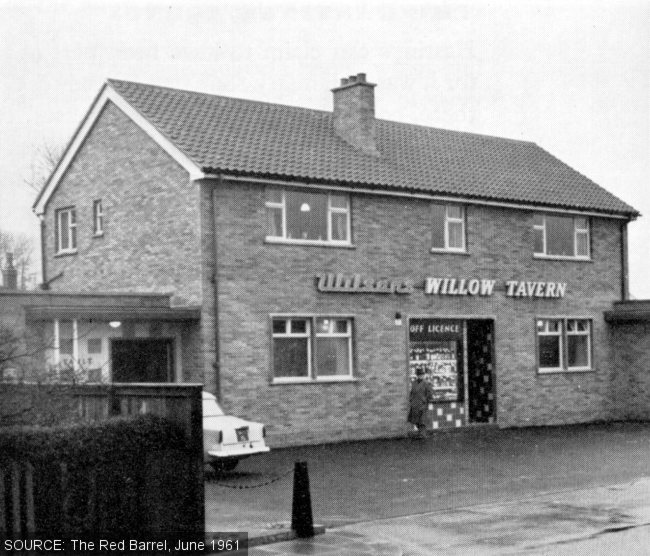
Wilson’s was a Manchester brewery taken over by Watney Mann in 1960. This, ‘one of their smaller houses’, illustrates the philosophy of the day perfectly: pubs shouldn’t look much different to the houses around them.
This photograph of the lounge is great, absolutely made perfect by the ghostly figure in the doorway — a reminder that there were actually people living, working and drinking in this perfectly posed pubs.

Since it was built this pub has been extended forward and is apparently still thriving — hooray!
11. The Roebuck, Lewisham, London

The above photo is a bit weird — taken from the top of a bus? Situated on Rennell Street this Whitbread pub was put up in only eight months and had a dive bar and saloon, ‘both with fitted carpets’. Here’s the saloon:

It’s long gone but Ewan from pubology.co.uk managed to nab a shot prior to demolition when it bore signs from a later incarnation as Bar Phoenix. From the comments on the Flickr page: ‘Was a queer pub in the 1990s & early 2000s under the Roebuck name. So most local people never went near it.’
UPDATE: Running Past now has an entire post on the Roebuck and its history.
12. The County Oak, Brighton, Sussex
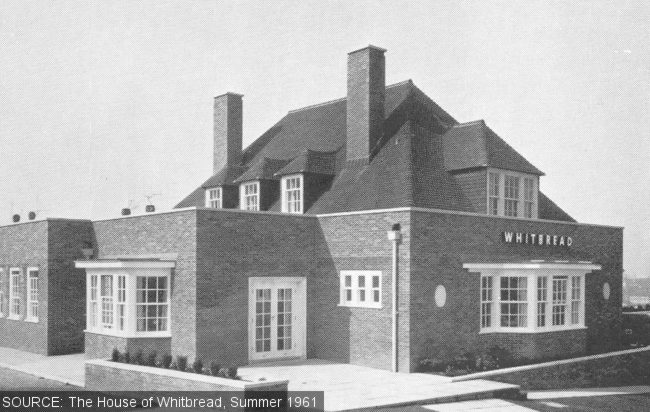
Currently the most famous pub in Britain thanks to a bad review in the local newspaper that went viral last week, the County Oak was launched with great pride by Whitbread in 1961. It replaced a 1950 post-war prefab which closed in March 1961; this new version opened the very next day.
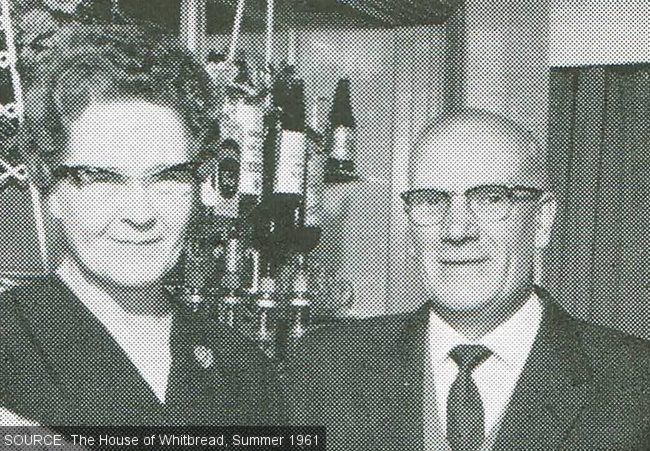
The first managers were Edward Purdin and his apparently nameless wife who had previously run the prefab version of the same pub.
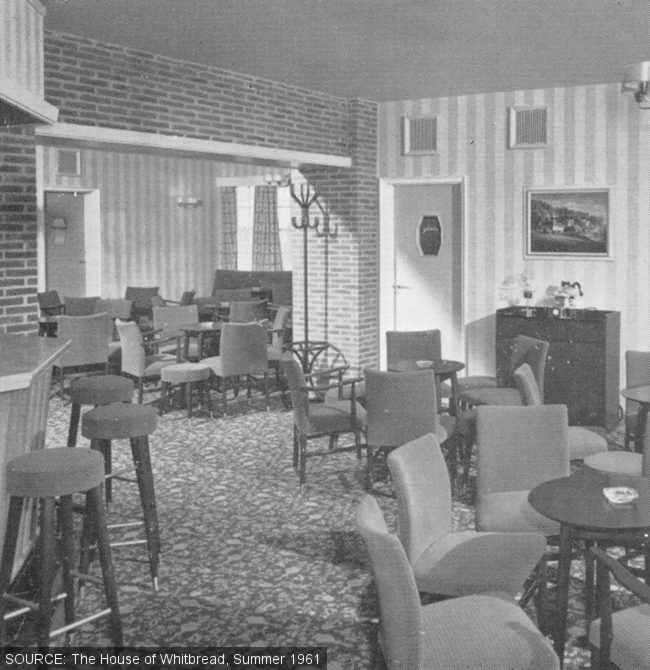
It had a saloon bar — soft furnishing, carpets, pictured above — and a public bar — wipe clean, like a swimming pool reception area, pictured below.

13. The King’s Head, Coventry, West Midlands

The King’s Head was a Phipps pub on Blackberry Lane on the Lyng Hall Estate. It was designed by the Northampton brewery in-house architects department. Above is the lounge (another vertically striped bar — this was obviously a thing) and you can see the exterior right at the top of the post in the featured image.
It opened officially on 16 May 1961. Nowadays, though the building is intact, it is a banqueting venue known as King’s.
* * *
That’s it for this batch. Just a reminder that if you or your relatives have any old brewery in-house magazines you’re thinking of slinging in a skip, do drop us a line first.


8 replies on “Modern Pubs of 1961: Watney’s & Whitbread”
A lovely piece, thanks for bringing it together.
Perhaps surprisingly, I don’t think ANY of those have been in the Beer Guide in modern times, based on my own travels.
Not that that matters, of course; it’s pleasing so many still going.
A lot of Watney and Whitbread pubs ended up being owned by Enterprise, which is not a recipe for quality.
Still a couple of pics of the Highwayman on the CAMRA heritage site
https://pubheritage.camra.org.uk/pubs/historic-pub-interior-entry.asp?NatPubID=SWL/2807&Detail=brief
Ah, thanks, Scott — we searched but couldn’t find it.
Not a *land* mine, surely?
That’s what the mag says and the Imperial War Museum website informs us that “they became known to the British populace as ‘Land Mines'”.
http://www.iwm.org.uk/collections/item/object/30020471
I didn’t know about the Orpington chicken, but there’s another Kent connection, in that the Royal East Kent Regiment were known as the Buffs – and a merger meant that they did briefly cover all of Kent.
#8 – is the offie a response to restrictive licensing hours? “The proximity of housing means you have to shut at 9.30, but we’ll encourage off-sales to compensate” ??? Of course, these days the offie would be a bottle-&-growler shop…
I was going to get all snobby and snotty about 8, and say “what else is there to do in Dunstbable?”, and sneer even more about the destiny of 13 – “a banqueting suite in Wyken?” – but then I saw it includes an Indian restaurant, and all of my negativity evaporated.
It’s great to see how these places were, and to understand the sense of optimism around some of them at least. I had always assumed this type of pub had been designed to be as cheap as possible, nothing more, but it’s fascinating to understand some of the intended social engineering behind them.